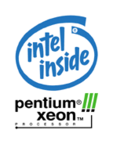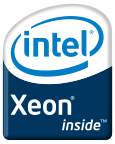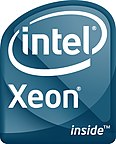Intel Xeon

Xeon is the brand name of server and workstation processors from Intel . These are based on the current desktop processor variants and thus on different micro-architectures.
In addition to CPUs under the name Xeon, GPUs under the name Intel Xeon Phi have also been offered since 2012 , which are based on the architecture previously presented as Larrabee .
Generations
| 1- or 2-socket systems 3000/5000 / E3 / E5-1xxx and 2xxx / E7-2xxx |
4- or 8-socket systems 7000 / E5-4xxx / E7-4xxx and 8xxx |
|||||
|---|---|---|---|---|---|---|
| process | Code name | Number of cores | Published | Code name | Number of cores | Published |
| 250 nm | Drake | 1 | Jun 1998 | |||
| Tanner | 1 | Mar 1999 | ||||
| 180 nm | Cascades | 1 | Oct 1999 | |||
| Foster | 1 | May 2001 | Foster MP | 1 | Mar 2002 | |
| 130 nm | Prestonia | 1 | Feb 2002 | |||
| Gallatin | 1 | Mar 2003 | Gallatin MP | 1 | Nov 2002 | |
| 90 nm | Nocona | 1 | Jun 2004 | |||
| Irwindale | 1 | Feb 2005 | Cranford | 1 | Mar 2005 | |
| Potomac | 1 | Mar 2005 | ||||
| Paxville | 2 | Oct 2005 | Paxville MP | 2 | Dec 2005 | |
| 65 nm | Dempsey | 2 | May 2006 | |||
| Sossaman | 2 | Mar 2006 | ||||
| Woodcrest | 2 | Jun 2006 | Tulsa | 2 | Aug 2006 | |
| Conroe | 2 | Oct 2006 | ||||
| Clovertown | 4th | Nov 2006 | ||||
| Allendale | 2 | Jan 2007 | ||||
| Kentsfield | 4th | Jan 2007 | Tigerton | 2 | Sep 2007 | |
| 45 nm | Wolfdale DP | 2 | Nov 2007 | |||
| Harpertown | 4th | Nov 2007 | ||||
| Wolfdale | 2 | Feb 2008 | ||||
| Yorkfield | 4th | Mar 2008 | Dunnington | 4/6 | Sep 2008 | |
| Nehalem XP | 2/4 | Mar 2009 | ||||
| Bloomfield | 4th | Mar 2009 | ||||
| Beckton (65xx) | 4/6/8 | Mar 2010 | Beckton (75xx) | 4/6/8 | Mar 2010 | |
| 32 nm | Westmere-EX (E7-2xxx) | 6/8/10 | Apr 2011 | Westmere-EX (E7-4xxx / 8xxx) | 6/8/10 | Apr 2011 |
| Sandy Bridge EP | 2/4/6/8 | Mar 2012 | Sandy Bridge EP (E5-46xx) | 4/6/8 | May 2012 | |
| 22 nm | Ivy Bridge (E3 v2 / E5-1xxx / 2xxx v2) | 2/4 /.../ 10/12 | Sep 2013 | Ivy Bridge-EP (E5-46xx v2) | 4/6/8/10/12 | Mar 2014 |
| Ivy Bridge-EX (E7-28xx v2) | 12/15 | Feb 2014 | Ivy Bridge-EX (E7-48xx / 88xx v2) | 6/8/10/12/15 | Feb 2014 | |
| Haswell (E3 v3 / E5-1xxx / 2xxx v3) | 2/4 /.../ 16/18 | Sep 2014 | Haswell-EP (E5-46xx v3) | 6/10/12 /.../ 16/18 | Jun 2015 | |
| Haswell-EX (E7-48xx / 88xx v3) | 4/8/10 /.../ 16/18 | May 2015 | ||||
| 14 nm | Broadwell (E3 v4 / E5-1xxx / 2xxx v4) | 4/6 /.../ 20/22 | Jun 2015 | |||
| Skylake-DT (E3 v5) | 4th | Oct 2015 | ||||
| Kaby Lake (E3 v6) | 4th | Mar 2017 | ||||
| Skylake-SP, Xeon W, Xeon D-21xx | 4/6/8/10/12 | Jul 2017 | Skylake SP | 4/6 /.../ 26/28 | Jul 2017 | |
| Coffee Lake (Xeon E-21xx) | 6th | Apr 2018 | ||||
| Coffee Lake (Xeon E-22xx) | 8th | Apr 2019 | Cascade Lake-SP / AP | 4/6 /.../ 26/28/56 | Apr 2019 | |
The Xeon brand for (multi-socket) server processors was introduced in 1998. At that time it replaced the server systems that were still based on the Pentium Pro. The first generation was a Pentium-II extended for multi-socket operation from 400 MHz clock frequency with its own slot 2 and its own chipsets.
The second generation ( Intel Xeon (NetBurst) ) came on the market in May 2001. It was based on the NetBurst micro-architecture and thus on the Pentium 4 . Here, too, separate sockets were used, and double-core processors also appeared for the first time in this generation .
The third generation ( Intel Xeon (Core) ) was introduced in October 2006. It had the core micro-architecture as the basis and the core 2 series as desktop dendants . For the first time there were Xeon-UP models for single processor systems (see also naming system ) and four-core processors, later even models with six cores.
The fourth generation, see Intel Xeon (Nehalem) , was launched in March 2009 and is based on the Nehalem micro-architecture . The corresponding counterpart in the desktop market is the Core i7 . In 2010 a Nehalem shrink from 45 nm to 32 nm structure width with the code name "Westmere" and small improvements in the micro-architecture was published. The Westmere EP variants for a maximum of dual-socket machines use the Nehalem naming scheme, for the Westmere EX variants (four and more sockets) the naming scheme was changed, they appeared with the name Xeon E7 and a four-digit product code.
The fifth generation was available from January 2011 and is based on the Sandy Bridge micro-architecture . The underlying desktop processor is the Intel Core i7, second generation. The Sandy Bridge Xeon family is called the Xeon E3 (single-socket variants) or Xeon E5, depending on the performance.
At the end of 2012 a shrink (from 32 to 22 nm structure width) with the code name Ivy Bridge appeared again . The Ivy Bridge variants of the Intel Xeon were called E3 v2 and E5 v2, variants with more cores appeared under the name E7 (v2).
Also at the end of 2012, a new product line appeared under the brand name Xeon, the Intel Xeon Phi computing accelerator cards, which had previously run under the project name Larrabee and should originally have been graphics processors . They follow the "MIC" (Many Integrated Cores) concept, i. This means that many simple processor cores are interconnected in a processor cluster.
The sixth generation appeared in 2013, see Intel Xeon (Haswell) . It is based on the Haswell microarchitecture, which has a structure width of 22 nm . The Xeon processor abbreviations are E3 v3, E5 v3 and E7 v3, with the E7 v3 increasing the number of cores again. For the multi-socket configuration, this is still the current Xeon series.
Introduced in June 2015, the Xeon E3-12xx v4 is the first Xeon series based on the Broadwell microarchitecture, the structure width decreases from 22 nm to 14 nm, which improves energy efficiency. As with the previous generation, the LGA1150 base is used. So far, only CPUs for single socket use with 4 cores are available. The main difference between desktop and server versions is the support for ECC memory in the Xeon CPUs.
At the end of the first quarter of 2016, the Xeon E5-2xxx v4 series was released, again based on the Broadwell micro-architecture, it is also called the Broadwell EX series. These are E5 v4 Xeons, which are suitable for multi-socket systems, see Intel Xeon (Broadwell) . Since they are socket-compatible with Xeon Haswell systems (LGA 2011v3 socket), these systems can be easily upgraded.
Introduced in October 2015, the Xeon E3-12xx v5 is the first Intel Xeon (Skylake) series based on the Skylake microarchitecture, the structure width remains at 14 nm. New LGA1151 sockets are used that match the desktop core i5 / i7 processors (Skylake) were introduced. So far, only single socket and 4 cores are available. The main difference between desktop and server versions is the support for ECC memory in the Xeon CPUs. This is now DDR4 memory. For the first time, Xeon E3-1500Ms are also available for laptops with ECC.
The first Xeon E3 v6 variants of the Intel Xeon (Kaby Lake) generation will be sold in March 2017 . Intel now offers 3 generations of Xeon E3 processors at the same time. All three generations (Broadwell, Skylake and Kaby Lake) are manufactured in 14 nm lithography processes. Intel has thus abandoned its tick-tock development strategy; the Kaby Lake generation is called an optimization of the 14 nm process. Skylake E3 and Kaby Lake are socket and board compatible because they use the same chipsets.
The Skylake server processors , called Scalable Processor (previously also known as Skylake-EP / EX) will appear in July 2017. They are NUMA processors with AVX-512 - SIMD extensions, they support up to 8 processors in one machine. The chronological order of the publication clearly documents that the E3 Xeons with the Core i variants of the corresponding generation are technically much more similar than with the E5 / E7 or SP server variants.
In April 2018, two mobile processors of the Coffee Lake series, called Xeon E , appear, with which the naming scheme with E3 has apparently been abandoned. In contrast to previous generations, these single-processor variants now have 6 cores instead of the previous 4.
The successor series to the Skylake server series, Xeon Cascade Lake , will appear in April 2019 , which are socket-compatible with their predecessors (Purley server platform). The VNNI-AVX-512 instructions for deep learning applications and a multi-chip module consisting of two ICs for high-performance computers are new .
Naming system up to Intel Sandy Bridge micro-architecture
With the P6-based Xeon models, Intel simply called all models “Pentium II Xeon”, “Pentium III Xeon” and added the respective clock frequency to the name. Based NetBurst with the introduction of Xeons were called these processors but then "Xeon DP" or "Xeon MP", depending on whether they for dual-processor systems ( " d ual p rocessor") or for multiprocessor systems ( " m ulti p thought rocessor") were.
Since the NetBurst-Xeons developed a very large variety of models over time, Intel switched to a model number system at the end of 2005:
- First of all, the two-letter abbreviation “DP” or “MP” describes the purpose of the processor.
- This is followed by a four-digit model number that allows a rough classification of the performance.
- The first digit correlates with the purpose: DP processors have a 5 here, MP models a 7.
- The second digit provides information about the generation, counting from 0. The higher this number, the newer the processor.
- The last two digits distinguish models with different clocks or with different features within a generation. In general, it can be said that a higher number combination indicates a more powerful processor.
- An optional letter "M" or "N" can be added directly to the number to distinguish models with different FSB frequencies.
- Last can still follow the suffix "LV", the L ow V oltage processors distinguishes that a lower TDP LV models have non-as.
- Example: The “Xeon MP 7140M” is intended for multi-processor systems (“MP” and “7”) and represents a relatively powerful model in the second MP generation (“1”) (“40”). The FSB clock is 200 MHz ("M").
This system was expanded with the release of the core-based Xeons. Now Xeon models were available for single-processor systems ( " u ni p rocessor") are available. Instead of “DP” or “MP”, these were given the abbreviation “UP” and the first model number was the 3.
Soon after the introduction of this third generation, a letter was added that gives a rough indication of the processor's TDP. This is directly in front of the four-digit model number and replaces the optional suffix "LV". There were initially the three variants E, X and L; since the fourth generation has been on the market, W has been added.
- Ordinary models with an average TDP of 65 to 90 watts get “E”.
- "X" are given to models with a higher TDP of over 90 watts. These are often clocked higher than electric models.
- All Nehalem-based Xeons with a particularly high TDP of 130 watts have "W". They usually represent the top models of their generation.
- “L” indicates low-voltage processors that have a lower TDP of less than 65 watts.
Example: The "Xeon DP X5460" is intended for two-processor systems ("DP" and "5"), has an increased TDP ("X") and is the fifth DP-X generation ("4") a powerful model ("60").
Naming system from Intel Sandy Bridge micro-architecture
Intel Marketing is introducing a new naming system that basically divides into 3 series and starts with "E" for Xeons:
- E3 : Processors for single socket systems (workstations)
- E5 : Processors for single-socket systems (servers) or multi-socket systems (servers), usually without an integrated graphics unit
- E7 : Processors: High-end processors for multi-socket systems with even more CPU cores or special functions such as transactional memory
The Xeon processor names have the following structure:
- Intel ® Xeon ® Processor [ E3 | E5 | E7 ] -x xxx [ | M | L ] [ | v2 | v3 | v4 | v5 | v6 ]
- 1 222 33333 4444444444444444
With
- first digit: max. Number of bases per system
- three-digit variant number: no system
- optional suffixes: for TDP, max. Memory expansion, ...
- optional suffix for architecture: none or v2 to v6
- : Sandy Bridge microarchitecture (without architecture suffix)
- v2 : Ivy Bridge micro-architecture
- v3 : Haswell micro-architecture
- v4 : Broadwell micro-architecture
- v5 : Skylake microarchitecture
- v6 : Kaby Lake micro-architecture
technology
Xeon processors are usually derivatives of the desktop processors of the respective generation, but they differ in various features. Because of their multi-processor capability, the DP and MP models in particular use special sockets and usually have significantly more cache or even a further level in the cache hierarchy. In addition, Xeons are often the pioneers of technological innovations that will later be introduced in the consumer market, such as hyper-threading or dual-channel memory access. In order to support the individual features and add more to them, Xeons often have to be operated with special chipsets .
Xeon-UP processors, however, have a special position because they usually correspond exactly to their desktop counterparts. Therefore, they also use the same base and offer the same features.
Since 2004, Xeon processors have also included Intel 64 , the Intel implementation of the AMD64 extension. This made the Xeons 64-bit capable, which competitor AMD had already been able to offer with the Opteron . However, this measure torpedoed Intel’s efforts to gradually replace the Xeon product line with the IA-64 processors of the Itanium series .
The extended equipment of Xeon processors is reflected in a significantly higher price compared to the respective desktop variant. Xeon-compatible motherboards , coolers , housings and power supplies are also significantly more expensive, since they are designed for high operational and data security.
competitor
In addition to Intel, there is only one larger supplier of x86 -compatible processors, AMD . However, AMD concentrated on the private customer business for a long time and only tried in 2001 to place a competing product on the server and workstation market with the Athlon MP . This failed, however, and Intel retained a quasi-monopoly position in this market segment. It was only with the Opteron that AMD was able to celebrate successes and take away some market shares from Intel. The Xeon is by far the market leader for x86-compatible server and workstation processors, but AMD is trying to regain a foothold in this segment with the help of the new Zen architecture, to be more precise with the Epyc and Threadripper processors.
Use for game computers
The model E3-1231 v3 of the second Haswell generation achieved great popularity especially among customers who use their computer for computer games and need a correspondingly powerful processor, but no integrated graphics unit ( IGP ), as a dedicated graphics card is used anyway . The big advantage of the model is that it is almost identical to the Intel Core i7-4770 and therefore delivers almost the same performance, although the IGP was dispensed with, which makes the processor significantly cheaper.
In the meantime, however, the use of XEON E3 v5 processors on conventional mainboards has become more difficult for gamers: An error message is displayed when starting the chipsets Z170, H170, Q170, Q150, B150 and H110. The problems do not occur only on the server chipsets C232 and C236. The previous generation XEON E3 v3 was not affected by the problem.
See also
Web links
Individual evidence
- ↑ Michael Günsch: Epyc 7xx2: Rome is AMD's 64-core breakthrough in the server. Retrieved February 6, 2020 .
- ↑ AMD on the rise: Intel's market share for servers soon below 90%? March 28, 2019, accessed February 6, 2020 .
- ↑ Volker Rißka, Jan-Frederik Timm: 100 MHz more for the E3-2130 v3. In: Computerbase. May 11, 2014, accessed October 20, 2015 .
- ↑ Andreas Link: XEON E3-1231 v3 in the test: Is the XEON still an insider tip? In: PCGamesHardware. June 25, 2014, accessed October 20, 2015 .
- ↑ Marc Sauter: Intel blocks server processors on desktop mainboards. In: golem.de. October 20, 2015, accessed October 20, 2015 .



